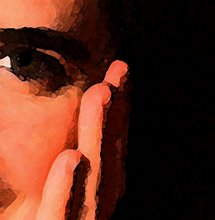This post has been simmering on this blog's back burner for a long time. So I wonder if I should not even post it, given that it refers to something that happened a few weeks ago, practically an eternity in blog time. Indeed, my observance of Rosh Hashanah and Yom Kippur seem like they were in another era. The weather was still summer-like for Rosh Hashanah and just days before I had begun moving into my apartment in Denver, my life change coinciding nicely with the change of seasons and the Jewish New Year.
I chose to spend these holidays with Nevei Kodesh, a Jewish renewal congregation in Boulder, about 35 minutes away. We worshipped in the town's Seventh Day Adventist Church, a spacious and sparsely decorated building that was easily converted into a synagogue for the Days of Awe. Congregants turned out in large numbers, filling the sanctuary with white or light-colored clothing for the holidays. Personalized tallitot, prayer shawls, added a bit of color, as did four chuppot, canopies, one in each corner of the large room.
Each of the chuppot, which were draped with brightly painted silk fabrics, represented one of each of the Four Worlds, or ways in which one can connect with holiness. There was the chuppa for Assiyah, the Physical World; another for Yetzirah, the Relational World; a third for Briyah, the World of the Mind; and finally for Atzilut, the Spiritual Realm Beyond Time and Space. Each canopy provided a semi-private space for silent meditation and prayer on the relevant subject matter. As someone who takes the High Holidays seriously and doesn't view services as primarily a time to socialize, I was grateful to have the option to be with the group but in a private space.
It turned out that I worshipped with like-minded souls and I never felt the need during services to duck under a chuppah to have some quiet, although I napped in Yetzirah during the mid-afternoon break on Yom Kippur. The rabbi offered plenty of opportunities in the services for silent contemplation in between the recitations and incantations of the ancient prayers, effectively hitting the pause button and allowing our own words and thoughts to sink in. And during the Torah service I was grateful for the group aliyot, the calling up to the Torah, based on creative psychologically-oriented interpretations of the ancient texts. For example, on Rosh Hashanah we read the tale of Sarah's late-in-life pregnancy with Isaac and her banishment of Hagar and Ishmael into the desert. When Sarah discovers that she will have a child, the Hebrew text uses a word that could be interpreted as laughter or mocking. Is Sarah laughing in delight or is she afraid of being mocked? For the reading of this passage the rabbi asked all of us to come up who were on the edge of faith, those of us who teeter between letting out belly laughs because we recognize that life has been unfolding in a way that supports and nurtures us, and between mocking or doubting the existence of a higher power. Since I probably teeter on this edge many times a week if not every day, I walked to the front of the room, as did a third of the congregation. Once the Torah reader had completed the passage the rabbi blessed all of us to find the kind of faith that would allow us to live fully and fully aware of the miraculousness of life itself.
I went up for a few more aliyot, as did many of the people there. Unlike in more traditional synagogues, in Jewish Renewal aliyot are not rationed or bestowed upon a handful of people, rendering the rest of the congregation observers rather than active participants in the service. The only exception to this was the final aliyah, where the rabbi called to the Torah and blessed Reb Zalman Schachter Shalomi, the 80-something year old founder of the Renewal Movement, referring to him as the wellspring of this fluorishing branch of Judaism. May he live to be a hundred and twenty.
Sunday, October 19, 2008
Subscribe to:
Post Comments (Atom)




No comments:
Post a Comment